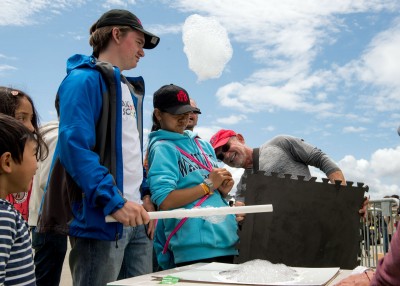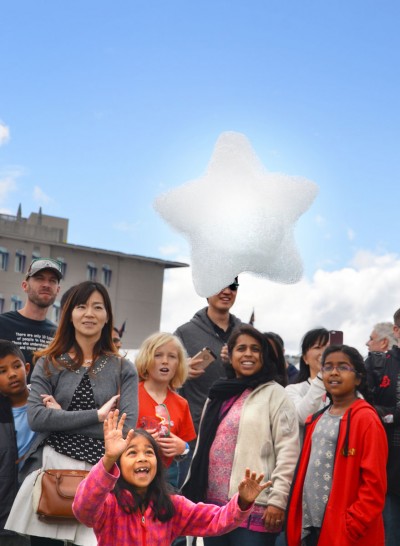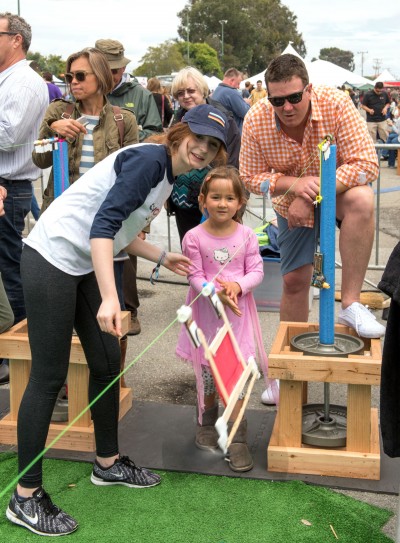In preparation for the Faire, Oakwood makers asked themselves what they wanted to share with the larger tech-influenced DIY community. “I’d want to play if I were an adult here,” said S.T.E.A.M. department chair, Marcos Arias. “I’d like to be able to see something interactive, I’d like to be challenged, and at the same time I’d like to build something. I don’t know what it would be, but I’d like to build something and mess around with it and work through iterations if I had the opportunity.” In response, students spent six months conceptualizing, designing, fabricating, and testing all components of “The Playground,” a 2,400 sq. ft. space divided into three sections: zipline racer building, 3D bubble printer, and maker mindset challenge.
Their planning was dead on. The wildly popular interactive play space had a constant stream of visitors lining up to watch, listen, build, and compete. “It’s intense being here,” admitted Zeke ’19. “We’re putting a lot of hours in. But it’s great because the amount of effort we put in is the amount we’re getting out.”
Before the Faire, students tested a variety of zipline racers, and in the end settled on a template that used the least amount of supplies and was simple enough for very young builders. But it didn’t just appeal to the young. “We’ve noticed the age range of our zipliners has been great—we honestly did not expect that,” said Arias. “One of the kids came over to me and said, ‘An older gentleman has been there for, like, ten minutes enjoying it.’ Unexpected but awesome. How can you turn something like that down?”
Harrison ’18 encountered the unexpected with his 3D bubble printer as well. A steady wind blew through The Playground all weekend, throwing off the device’s bubble production. As he and Arias discussed altering helium levels and best practices for making “less wet” bubbles, onlookers got a lesson in making sturdy, dense bubbles while a gaggle of youngsters hovered close to the Plexiglas tank, trying to sneak their hands in to pop the rising bubbles. But the adjustments weren’t generating the bubbles that Fuller and Arias were used to working with; they knew something else was off. Midway through the event, they learned that the tap water at the Faire was harder than the tap water at back at school, so Arias went out and bought bottled water. It was just the fix the printer needed; it worked at peak performance for the rest of the weekend, allowing enthusiastic crowds to enjoy the dreamy spectacle of star-shaped suds floating as far as the eye could see.
The maker mindset challenge was made up of three basic areas: cup jumping, large-scale Tetris, and Jenga. They tested players’ dexterity, manipulation, and logic—each within a five-minute time limit. The rules: Players could work as singles, pairs, or triples; the player with the lowest cumulative time at the end of the Faire would win a 3D printer. “We’ve learned that singles and doubles work much better than triples. No one has been able to get through as a triple,” Arias said. “You would think that a group of three would work through it, but actually it ended up being a communication thing.” As a familiar group approached, he looked up and smiled. “Oh yeah, these guys have been through three or four times now. They want that printer.”
Another take-home lesson: “We found that by sizing things up, it adds in a different play,” explained Arias. “And we colored them, thinking it would play with your mind a little because you’re paying attention to the color. But we’ve discovered that color doesn’t make a difference.”
Maker Faire is an event where people meet, share, teach, and learn about the things they make. While Oakwood students spent fifty percent of their time working The Playground, they spent the other half walking around the Faire gathering ideas and inspiration to bring back to the iLab. Exhibits this year ranged from unconventional to entrepreneurial, from drone races and tape sculptures to wind powered acoustic instruments and self-driving solar-powered boats. “It’s really amazing to see how large the S.T.E.A.M. community is in California,” marveled Hannah ’18. “And it’s cool how inspired people are. I’ve seen so many things here that we can bring back to our department.” Her top pick was a filament attachment that would allow their 3D printer to print in color.
Maya ’18 was eager to bring the 3D color attachment back to school, too, but what she valued most about being at Maker Faire were the interactions she had with people at The Playground. “At school events, people know what to expect, they’ve heard about the zipliners or rockets, so they’re not that surprised. But here, we’re seeing people’s first reactions, and that’s really cool.”
Maker Faire founder, Dale Dougherty, designed the event to be forward-looking, a call to the next generation to tinker, shape, and reshape the world around them. “All of us are born makers. We have this ability to grasp things with our hands. We use the word grasp metaphorically to think about understanding things,” he said. “My goal is that all people, young and old, come to see themselves as makers, creators and doers because I know that the people who have the skills and knowledge to make things have the power to make the world a better place.”
Oakwood S.T.E.A.M. Council returned with more than lessons and new ideas. They also took home ribbons for Maker Faire: Best in Class and Maker Faire: Editor’s Choice, ending the trip with a sense of satisfying closure.





